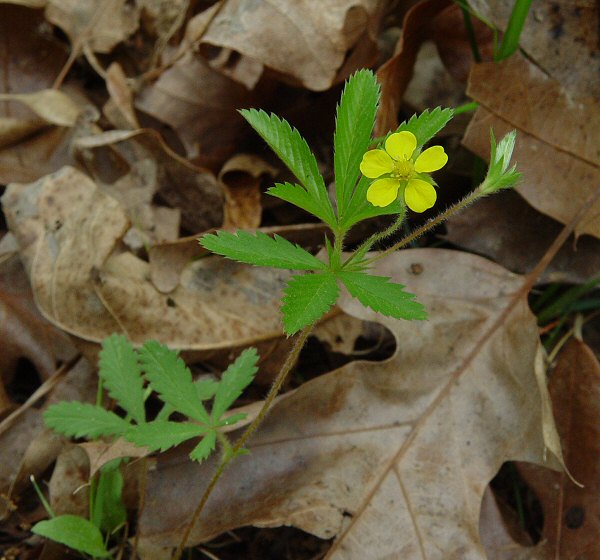Potentilla simplex Michx.
Common Cinquefoil

Native
CC = 3
CW = 3
MOC = 82
© DETenaglia
Potentilla simplex Michx.Common Cinquefoil | |
 |
Native CC = 3 CW = 3 MOC = 82 |
© DETenaglia |
|
Family - Rosaceae Habit - Perennial forb with short rhizomes. Stems - Ascending, to 1.5 m, becoming arched to spreading and stoloniferous, often rooting at the tip (then producing small tubers that are infrequently collected, these giving rise to new plants) and occasionally also rooting at some of the widely spaced nodes, usually moderately pubescent with spreading to appressed hairs.
Leaves - Basal and alternate, palmately compound, sometimes produced in small clusters on short, axillary branches. Petioles of basal leaves 1-15 cm long, those of stem leaves absent or to 1.5 cm, when present usually hairy. Stipules of basal leaves 10-18 mm long, narrowly lanceolate, entire or with a pair of lateral lobes, those of the stem leaves variously 5-30 mm long, lanceolate to broadly elliptic, pinnately several-lobed, hairy. Leaf blades 3-8 cm long, palmately compound with usually 5 leaflets, these 2-8 cm long, sessile, oblanceolate to elliptic or narrowly obovate, the central leaflet usually 2 or more times as long as wide, bluntly pointed at the tips, the margins coarsely toothed, the upper surface green, glabrous or sparsely to moderately hairy, the undersurface lighter green, sparsely to moderately hairy (the hairs sometimes silky and appressed, the surface then appearing somewhat whitened).
Inflorescence - Inflorescences axillary, of solitary, long-stalked flowers, the lowermost flower produced from the axil of the second-lowest stem leaf. Flowers - Bractlets 2-5 mm long, narrowly lanceolate, sometimes pinnately few-lobed, moderately hairy. Hypanthia 3-5 mm in diameter, cup-shaped. Sepals 4-6 mm long, lanceolate to elliptic-lanceolate, sharply pointed and sometimes with a minute extension of the midvein at the tips. Petals 4-7 mm long, obovate, rounded to very shallowly and broadly notched at the tip, rich yellow. Stamens 20. Ovaries with the styles attached near the tips.
Fruits - Achenes, densely aggregated on the surface of the hemispheric to somewhat elongate receptacle, 0.9-1.2 mm long, the surface smooth or faintly ribbed or wrinkled, yellowish brown, unwinged. Flowering - April - June. Habitat - Prairies, forest openings, glades, savannas, bluffs, streambanks, fields, pastures, roadsides, railroads, open disturbed areas. Origin - Native to the U.S. Lookalikes - Other species of Potentilla. Other info. - This little trailing species is common throughout most of Missouri, as well as most of the eastern half of the continental U.S. It is easily recognized by its trailing, somewhat sprawling habit, palmately 5-compound leaves, and bright yellow flowers. The species does exhibit a fair bit of morphological variability, particularly with respect to leaf and stem pubescence. Steyermark named three varieties based upon these characters, but other authors have chosen to consider them as representing a continuum of variability within the species. Photographs taken at Whetstone Creek Conservation Area, Callaway County, MO., 5-4-04 (DETenaglia); also at Weldon Spring Conservation Area, St. Charles County, MO, 5-11-2010, and Canaan Conservation Area, Gasconade County, MO, 5-6-2014 (SRTurner). |